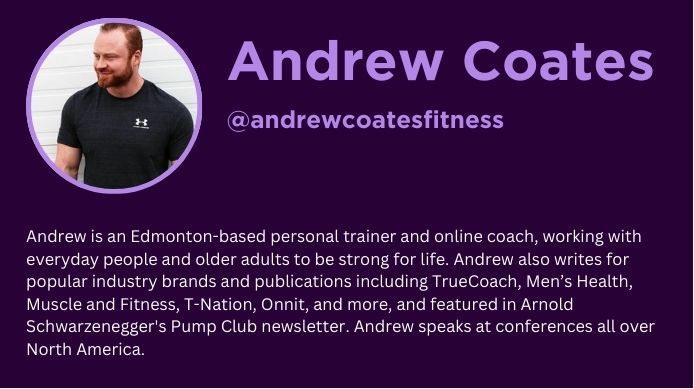Online training now feels mainstream but it wasn’t long ago where the average person didn’t know online personal training existed let alone an option they would consider.

How Did Online Training Originate and Develop?
To understand why online training is as accessible and valuable as it now is, we need to look at how it evolved. Online training was largely confined to 2 different trainer niches from 15+ years ago:
1) Bodybuilding Origins
The foundation of online coaching started with bodybuilding coaches who gave their clients program and meal plans. Bodybuilding coaches didn’t always train hands on with clients. Clients were often sent a program and meal plan(programs and plans that weren’t always as “individualized” as claimed). And depending on the mood of the coach or frustration level of the client, the coach added or removed more rice or peanut butter.
Later, some coaches emerged with higher level education, notability figures like Dr. Layne Norton and Paul Revelia. Truly individualized programs became the norm, along with deeper client relationships. More evidence based educational resources in nutrition and strength training improved the quality of coaching and client results, influencing a new generation of coaches, in-person and online.
Many powerlifting coaches worked the same way, periodizing programs for their athletes. Their clients would often pay for added in-person training on top of their online programs.
2) Evidence Based Pioneers
Influenced by the first wave, but serving a more generation population of clients, another type of online coach emerged: a small group of forward thinking trainers who’s reach and reputation created demand for their skills beyond their immediate geographic ability to coach in-person. These coaches developed systems (initially spreadsheets and email), comprehensive intakes and assessments, and worked to foster deeper relationships with their distance clients that mirrored in-person coaching.
Many of the early T-Nation coaches from the strength and conditioning world were the early popularizers, including Dean Somerset, Tony Gentilcore, and John Berardi, who built and scaled this approach into Precision Nutrition. Add coaches like Adam Bornstein (who’s worked with Arnold Schwarzenegger and Lebron James) and Jennifer Van Barneveld, and you have a small group of online coaching trailblazers. Leila Hormozi also offered a lot of online coaching early in her career as husband Alex frequently mentions in his books and media. Though it wasn’t rare, online training wasn’t yet common.
For the “average” commercial gym trainer, online coaching wasn’t an option or even on their radar as a consideration. Many gyms forbid their trainers from having outside coaching business.
Something changed, gradually but steadily, as more of the forward thinking coaches mentored and popularized online coaching, most visibly led by Jonathan Goodman, the first person to develop a formalized textbook online training certification, The Online Trainer Academy.
With the rise in demand for online coaching a handful of online coaching software providers entered the scene, TrueCoach among the leaders of this movement, allowing coaches to streamline their online service delivery and either use a default library of exercise demo videos or film and upload their own.
As more and more coaches embraced online coaching as a way to supplement their in-person income, or pipe dreamt of working from their laptops on the beach, with it came greater acceptance of online training as an option for consumers. Online training just needed a tipping point.
That tipping point came in 2020 with a global pandemic that shut gyms worldwide, and with it shuddered most trainer’s in-person businesses and livelihoods. This also left clients without access or support. Everyone scrambled to save their business and stay active. The only option was shift to online, so trainers went online or left the industry. Virtually all fitness consumers experienced some form of online coaching or program.
While people have rushed to re-embrace gyms for their workouts, many more setup home gyms and permanently shed gym memberships.
Concurrent to all this is the rise of social media and greater access to quality coaches world wide. No longer did local trainers have a monopoly on local consumers. People flocked to coaching with their favourite online personalities, whether 1 on 1 or into group programs by Don Saladino, Jordan Syatt and Susan Niebergall, Kelsey and Dennis Heenan, or Bret Contreras.
And as more high profile coaches popularize online coaching programs, more people see online training being as normal an option as visiting an in-person trainer.
Why Online Coaching Has Become Popular:
Online coaching has an impressive array of benefits to the consumer:
1) Access to the best coaches in the world, regardless of geography
Until recently, if you wanted a trainer, you searched locally, usually within a small radius in your city, and often by walking into the closest commercial gym and getting assigned to the newest trainer(once upon a time we were all that newest trainer). If you were from a small town your options we’re limited. Now you can theoretically work with anyone in the world. Potential clients can find you through social media, YouTube, your podcast, or your articles. One of my earliest online clients, Adam, found me through my early T-Nation articles and I now train his son.
Potential clients also have more opportunity to follow and gain a sense of personality and philosophy via consuming social media and long form content from coaches. A trainer’s love of heavy metal, the Witcher, or cats may be personal elements that a potential client gravitates to. Clients with young children may feel more connected to coaches who have kids.
2) Affordability
In-person one on one training can be pricey, especially in major cities like New York, Toronto, or Los Angeles. Clients who want multiple sessions a week look at several hundred to well over a thousand dollars a month. I know busy $500 an hour trainers in Manhattan. Skilled coaches work hard to create incredible value for their clients but such training isn’t affordable for everyone.
Online coaching may offer all the benefits a client values but at a fraction of the price. Having access to structure and support when needed for a few hundred dollars a month is often a great investment that gives back energy, productivity, confidence, and long term health, paying in value many times over the sticker price.
Online group programs offer the structure, support, and even community that clients value but at even lower cost, making such programs accessible to a much larger pool of potential clients.
3) Accountability
Spend enough time coaching in-person and you rightfully believe your client success and retention is based on your high touch point relationship. We as coaches often spend more time with our clients than we do with family and friends. We sometimes forget that this type of person self selects to in-person training. My older adult clients have the financial resources to train with me in perpetuity. My client Larry told me early in our time together that I would have him until he’s “dead”. I told him “Then it’s my job to keep you alive for as long as possible.” Larry values our time together and wouldn’t value online coaching.
We often forget that many people do value their coaching relationship but don’t need time together as much as they need structure, support when needed, and the ability to show up at the gym, shut their mind off and execute on the planned workout. Many people will happily pay to have everything planned for them, be held accountable, but don’t need regular “hand holding”.
By having one on one, group coaching programs, or even training apps available, more people have access to great programs and ongoing accountability.
4) Schedule Flexibility
Clients who want to train with experienced, reputable, and highly sought after trainers will pay a premium and still may not get their preferred training slots. Trainers may not always be able to offer flexibly week to week on booking times for a client who’s schedule varies or changes on short notice.
Having your workouts planned allows a client to show up when most convenient knowing exactly what to do. Online training may appeal more to such clients who require a high degree of flexibility.
5) Support and Coaching When Needed
While few coaches can be on demand in real time for their clients(Ben Bruno, Don Saladino, and Jeannette Jenkins probably make sure Justin Timberlake, Ryan Reynolds and Blake Lively, and Pink are all respectively well cared for), an opportunity for coaches to stand out with online coaching, is to massively over deliver on the industry standard “within 24 hours” response(this works for in-person training too).
With my online group strength program, I’ve gotten feedback that one of the most high value aspects for my members is my prompt, thorough, and individualized responses (via Facebook group or DM) to support and coach them when needed, while the structure and resources of my program covers most of their needs most of the time. They enjoy the program but stay for their trust that I’m there when they need me.
Some coaches may be motivated to scale online coaching to further remove themselves from interacting with people and place boundaries around access to them. Some coaches are drawn to resources like DM automations, AI, virtual assistants, or assistant coaches to further insulate themselves from working directly with people. I recommend caution anytime you’re misled to believe you’ll be more successful by misleading clients into thinking they’re interacting with you personally. This will likely cost you the very income and freedom you think you’ve created long term.
Side note: Creating a business and service that’s so in-demand that you need to hire assistant coaches, which creates jobs and livelihoods for others, while scaling your ability to deliver great service to more people, is a massive win for all and the foundation of industry standout brands like Macros Inc, Stronger U, Renaissance Periodization, and Precision Nutrition.
6) Online Training Lets Clients Keep Their Trainer Through Major Life Changes
We’ve all had clients who would have stayed with us for life except they moved cities or had some other significant life event that forced them to stop training.
Some trainers got started with online training when a loyal client moved away but wanted to find a way to keep coaching with them. My first online client was an in-person client who moved to another city.
For many trainers the unexpected loss of a client can hit hard. Having this option may initially help spare the income loss, and long term be the foundation of a growing income stream that leaves you less vulnerable to the seasonality and volatility of an in-person training business.
Sometimes clients have major life changes that don’t let them continue to train in-person but they value the support and relationship they still get from online training. Sometimes budget changes makes online training a better middle ground. I have several former in-person clients who enjoy my online group program. One’s schedule could never match up with mine, while others became so skilled and independent that the online group program and community was ideal support for them.
Client needs change and having more options for how clients can work with us often serves the client best on their terms.
Sometimes it’s the trainer’s life that changes. Some trainers leave in-person for full time online coaching for life flexibility. Some trainers move to support a partner’s career or be closer to aging parents. Aman Jaggi, a coach who contracted out of the same gym I do, moved across the country when he got married and some of his former in-person clients value his work and their relationship so much they coaching with him online.
7) Online Training Has Become More User Friendly
Often overlooked among the rest of the benefits, user friendliness has an outsized impact on popularizing trends and technologies. Online training started with spreadsheets, word docs, and emails. While some coaches became wizards with these basic tools, the client experience improved when high quality online coaching software took over.
Clients experience enough friction in their lives. Make their coaching experience a series of complicated steps and you hurt their success and your likelihood of retaining a successful client. TrueCoach and other high quality online coaching softwares allows user friendly program access on a visually pleasant web based app, ease of uploading their videos and notes, and features to streamline communication and tracking.
Some coaches like Steve Keane, Sharelle Grant, and Victoria Pal invested huge budget and time commitments into developing their own signature apps to deliver on a premium client experience and scaling their ability to serve more clients.
Parting Thoughts
As online coaching and programming becomes more mainstream, more technology companies will move into the space to create mass market apps and algorithms. Reputable coaches and fitness brands are building and growing training and nutrition software to scale coaching to more users. Many apps deliver quality programs for under $20 a month. The explosion of AI will make it easier for tech savvy consumers to get cheap or free programs. And there will come a day not too far from now where AI will create better programs than people will(yes much of the human relationship and nuance of coaching will take longer for machines to compete with).
But, there will always be people who choose analog over digital, who choose vinyl records over streaming music. There will always be people who self select to the personal relationship that comes from one on one coaching with a real person. This means there will always be lucrative careers for in-person trainers. It also means online coaches who make their online training as personal and in-person will thrive.
The mass adoption of online coaching isn’t a fight for a small pie, but an effort to grow a massive pie to share. There will be players with a winner take all mentality, but there will always be people who want to work with you, if you show them you care enough.

Sign-Up for Our Newsletter
Recommended Resources For You

Blog
Elevate Your Coaching – Answers to Your Top Training Questions
Author: TrueCoach
Whether you’re just starting out or looking to level up your fitness coaching career, these are the questions coaches like you ask the most. We’ve gathered insights to help you succeed at every step of the journey. 1. How do I increase my client retention? Consistency is key to client retention. Regular check-ins, personalized communication, […]

Blog
Mastering Exercise Programming for Personal Trainers and Fitness Coaches
Author: TrueCoach
Are you a personal trainer or fitness coach aiming to maximize your clients’ results? Meet your new best friend—exercise programming. This essential skill can transform how you guide your clients toward their fitness goals. In this blog, we’ll break down what exercise programming is, how it works, and the benefits it offers. Whether you’re new to the concept or looking to refine your skills, read on to discover how exercise programming can elevate your practice.

Resource
How to Craft and Curate Effective Workout Programming
Author: Clare Hudson
This ebook dives into the intricacies of designing workout plans that get results and boost efficiency for personal trainers.It breaks down key principles like periodization, progressive overload, and specificity, showing you how to create customized programs that fit your clients’ unique needs and goals.

Author: Andrew Coates FRSA CSM
-
First published: September 04 2024
Written by: Bobby O'Connell

